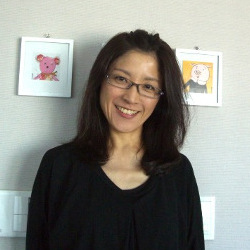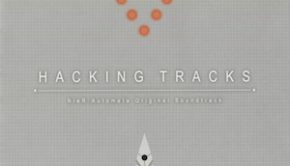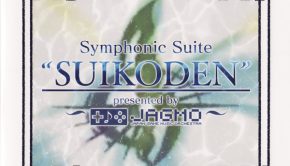Miki Higashino Profile
 |
Also Known As: 東野 美紀 (ひがしのみき) / Miki / Miki Ishikawa / Miki Yanigisawa / MIKI-CHANG |
| Date of Birth: January 1, 1968 (Takarazuka) |
|
| Residence: Tokyo |
|
| Game Works: Gradius, Suikoden, Contra, Tokimeki Memorial |
|
| Official Site: N/A |
History
| Organisation | Type | Tenure | Role |
| Konami | Game Developer | 1984 – 2002 | Composer |
| None | N/A | 2002 – | Retirement |
Biography
Miki Ishikawa (née Higashino, previously Yanigisawa) is a retired video game composer best known for her work on Konami’s Gradius and Suikoden franchises. Born on January 1, 1965 in Takarazuka to a musical family, Higashino was exposed to classical music by her father from a young age and learned to play the piano and sing from the age of five. During her teenage years, Higashino went on to form a band – regularly composing and singing original songs – while continuing to play the piano. Desiring a career in music, she majored in composition at the Osaka College of Music, but felt uninspired by the focus on atonal modernist music there and felt there was little room for innovations. Desperate for money and inspiration, Higashino was intrigued to learn that Konami was hiring part-time composers and successfully applied for the position in 1984. Unlike many of her successors, Higashino never dreamed of becoming a game composer – she didn’t play video games and had little idea what they sounded like. She simply stumbled on the job and ended up enjoying it so much that she made game composition her career.
As one of the company’s few composers, Higashino was given little direction and complete musical freedom on her initial projects. She initially created 13 compositions to accompany the massively successful space shooter Gradius, released in 1985 for the Arcade. She principally composed melodic music to stimulate listeners while playing the shooter, including the buoyant “Challenger 1985” to accompany the first stage. However, she took more progressive approaches to later stage music and the boss theme – conveying her concept of outer space using odd metres, rapid arpeggios, and the Lydian mode – while channelling influences from Kraftwerk’s use of synthesizers. Enjoying the process throughout, Higashino felt excited by “how the game’s cool, futuristic sounds coupled with the shining, beautiful graphics”. The score was modest in its composition and synthesis, at least by today’s standards, but began to reflect the potential of game music to her and observers alike. She was surprised to learn of the game’s success and unintentionally created one of the first popular game soundtracks. A testament to its influence is that the score inspired Yuzo Koshiro, Hitoshi Sakimoto, and Motoi Sakuraba to enter the industry.
Committed to creating more scores at Konami, Higashino created a short score for Yie Ar Kung Fu in 1985. To fit the setting and fighting style of the game, the compositions mostly used oriental scales and percussion. Still a part-timer, she went on to create write strong melodies for the MSX’s vertical-scrolling shooter Knightmare and the Gradius spinoff Salamander. With the latter, it was evident she had developed as a musician – the compositions were more thoroughly developed, featured groovier rhythms, and a stronger mood than her debut work. For its overseas adaptation Life Force, Higashino created three new stage themes with an energetic rock influence. The same year, she reprised her works for the NES port and co-composed a new score for its MSX version. Under the direction of Seiichi Fukami, she also contributed made three tracks for Gradius III; given there were far fewer limitations on the sound system compared with the first Gradius, she was able to write larger-scale pieces. To celebrate the popularity of the series’ shooters, Higashino produced two arrangements for Salamander Again and an elaborate arrangement performed by the London Philharmonic Orchestra on Gradius in Classic II in the early 90s.
Following her Gradius works, Higashino contributed to various other productions as a full-time employee. She soon co-composed the energetic score to the space-based beat ‘em up Surprise Attack and, by mixing obligatory arrangements of the series’ main theme with memorable new compositions, the Arcade adaptation of Teenage Mutant Ninja Turtles. Higashino went on to take leading roles on the scores for Contra III: The Alien Wars and Madara 2 for the SNES. Inspired by action movies, her score for the former was more dark and dramatic than her previous efforts, ideal for representing apocalyptic atmosphere and relentless pace of the run and gun title. By contrast, she blended oriental and orchestral sounds throughout the RPG Madara 2. While both scores were major successes, Higashino found using the PCM modules difficulted and requested not to work on further SNES scores. With guidance from DJ Masanori Adachi, she went on to manipulate the Mega Drive’s FM sound modules to create an electro-funk score and sound effects library for Teenage Mutant Ninja Turtles: Tournament Fighters. She simultaneously worked on several games that she was not credited for, for instance enjoying creating a line of scores for Konami’s kids-targeted Picmo Learning System.
Higashino nevertheless continued to challenge herself with several major projects. On Premier Soccer, she worked on everything except sound programming alone for the first and only time in her career. Describing the project as her favourite, she felt optimistic every day while working on it and enjoying writing in a more personal fusion style. For another sports game, Double Dribble, the artist meticulously created convincing dribbling sounds and beefed up snares and kicks despite the notorious limitations of the Mega Drive. The artist went on to contribute to the huge score to the TurboGrafx-16’s dating simulator Tokimeki Memorial in 1994. Benefiting from her band background, she focused her attention on composing pop-flavoured vocal themes that would be fondly remembered by teenage audiences. Her songs for the massively popular game were featured in a range of albums, singles, and drama release. Following this success, Higashino pursued vocal music further by collaborating with Mami Kingetsu, seiyuu of the first virtual idol Shiori Fujisaki, on Konami’s original single Almost Summer and the album Catchy. She found such experiences so fulfilling that she began to consider herself more of a songwriter than background music composer.
In 1995, Higashino composed the majority of the soundtrack to PlayStation RPG Suikoden, known as Genso Suikoden in Japan. Upon reading the scenario at the very beginning of the project, ideas on how to score the project soon rushed through her mind. The ethnically inspired but highly accessible soundtrack gushed with emotion, boasted excellent sound quality, and was jam-packed with gems. Higashino’s timeless main theme “Into a World of Illusions”, among others, remain an important component of the series’ legacy and have prominently featured in the series’ scores and albums since. The artist accredits the score being so lavish to her growth as a musician, her liberation from technical restrictions, and, of course, the inspiring scenario. Following its production, Higashino coloured Tamawari’s soundtrack to Vandal Hearts with ten compositions and made three additional compositions for the Gradius Deluxe Pack compilation. Also occasionally working on projects outside of Konami, she wrote lyrics on behalf of the Thelonious Monkees for Love-de-Lic’s Moon and had the honour of opening the original vocal album Ten Plants with “Tokyo Life” – an eccentric solo composition featuring youthful ethnic vocals and bustling electronic and organic forces.
Between these independent projects, Higashino worked on the epic sequel Suikoden II. From the beginning, she and the sound programmer were the only sound staff working on the project, so her responsibilities were enormous. She persevered to compose all but seven of its 105 tracks, between directing the sound effects, optimising the timbres, and recording performances. Widely regarded to be Higashino’s magnum opus, the soundtrack preserved the quality of the original and featured a full orchestral opening theme, creative Suikoden arrangements, and even several songs. The score also exposed Higashino’s name in the West given she received prominent credits on the game and the two volumes of soundtrack releases. She also directed Genso Suikoden II Music Collection ~Orrizonte~, a fascinating arranged album that used archaic musical instruments. Inspired by the success of the Suikoden II arranged album, her compositions for the series were arranged by a variety of external artists for eleven more arranged albums, most of them independent of her supervision. While still a resident composer, Higashino also embraced the opportunity to create a furious electronica piece “Future is Now” on Shinji Hosoe’s futuristic concept album 2197 in 1999.
Higashino’s final scores at Konami were the two Genso Suikogaiden scores. She treated these scores retrospectively, offering many arrangements of past Suikoden themes with more intricate musicality and enhanced sound quality. Nevertheless, she included a range of new compositions appropriate for the various new events and scenarios. Unfortunately, she continued to find production the Suikoden series’ scores incredibly tiring despite their rewards. Her time at Konami was dominated by meetings with the sound production division and development teams, but she was also expected to create a large number of compositions and sometimes act as a team manager. Her enormous responsibilities and perfectionist tendencies resulted in her working 12 hour days and experiencing disrupted sleep and fatigue. She felt her personal life suffered due to her work, yet had a vision of building a home and becoming a mother. Feeling she had worked hard enough and it was time to pursue her dreams, she decided to quit Konami in 2002. Her last contribution was a piano arrangement of her first major Konami composition, Gradius’ “Challenger 1985”. Looking back, she describes that trusting her feelings was the wisest decision that she ever made.
Since leaving Konami, Higashino’s life has greatly changed. After neglecting her personal life for her career for so long, she remarried, moved city, and became a mother. Nevertheless, she has remained busy, balancing bringing up her children with various projects outside game music. Despite being largely retired from game music, Higashino has occasionally found the time to create some new compositions. In 2005, she made a surprising but short-lived return to game music to create ten tracks for the PlayStation 2’s Tsukyo ni Saraba. She agreed to help Yasunori Mitsuda on the project after learning he was shorthanded, having maintained a friendship with him since Ten Plants. The pair used the time and budget available to craft a stylistic experiment. The entire score was composed in a jazz style for big band and some of the tracks even integrated rap samples. It wasn’t the return many expected, but many appreciated the creativity. Also that year, Higashino wrote the B-side of Yu Michigoe’s debut single alongside Kazumi Mitome. She appreciated this opportunity, still regarding herself principally as a songwriter.
In 2007, Higashino made an unexpected return to Konami with the music game pop’n music 15 ADVENTURE. Contributing two pieces, she created a warm electro-acoustic instrumental “Forest Song” and the uplifting J-Pop song “FU-FA”. In recent years, Higashino has also offered some tributes to her past works. A year later, she remixed the Life Force track “Slash Fighter” in a techno-pop fashion for the shooting tribute game Otomedius G and oversaw the retro arrangements of Gradius ReBirth. Though asked to contribute to Suikoden Tierkreis, her busy schedule prevented her from committing. Most recently, she contributed a special track to GE-ON-DAN’s charity album The Land of the Rising Sun to raise relief funds for the Tohoku earthquake. Despite being largely absent from the industry in the last ten years, Higashino has evidently left a lasting legacy through her work on the Suikoden, Gradius, and Tokimeki Memorial series. There is optimism that she may one day create some original instrumental or vocal albums. After all, she has mentioned her eagerness to create a French-themed album and once joked ‘if someday, you go to a comic market, and find an old lady secretly selling CDs at the side that would be me’.
References:
– Various Game & Album Credits
– VGMdb Discography
– Personal Profile (Facebook)
– Interview with Yasunori Mitsuda (English, May 2000)
– Interview with Game Music Online (English, January 2012)
© Biography by Chris Greening (September 2007). Last updated on December 30, 2012. Do not republish without formal permission.
Posted on December 30, 2012 by Chris Greening. Last modified on March 21, 2014.














